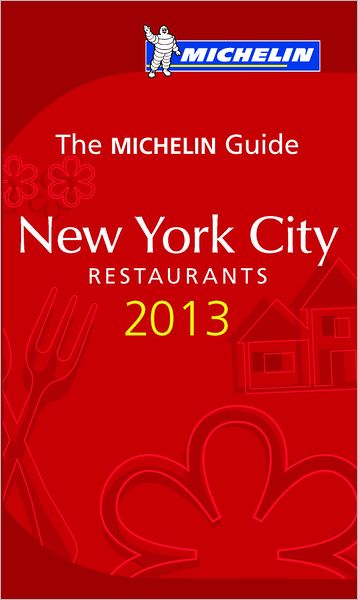 The Michelin Guide to restaurants has been around for more than 100 years and claims more gravitas, by sheer longevity, than most other dining guides. Recognition bestowed by this particular institution, known as the Red Guide, can make or break a restaurant -- "especially in France," said Rita Jammet, one of New York's celebrated foodies, at the New York awards celebration last night. Ms. Jammet and her husband, Andre, owned the iconic restaurant La Caravelle in New York. Chef Jammet's roots go back to his family's hotel, Le Bristol, considered one of the finest in France, where the prestige power of Michelin's stars, quite impressively, still charts the course of the French dining scene. Gaining a star, or two, can boost a restaurant's customer base and launch a chef onto the world scene; losing a star can result in profound loss of esteem and business.
In Italy, there is generally a different story to tell by those well acquainted with authentic regional cuisine. Arthur Schwartz, author of Naples at Table and The Southern Italian Table, says that his colleagues there stay clear of Michelin-starred restaurants. "They are not Italian," he smiles, "they are French."
The Michelin Guide to restaurants has been around for more than 100 years and claims more gravitas, by sheer longevity, than most other dining guides. Recognition bestowed by this particular institution, known as the Red Guide, can make or break a restaurant -- "especially in France," said Rita Jammet, one of New York's celebrated foodies, at the New York awards celebration last night. Ms. Jammet and her husband, Andre, owned the iconic restaurant La Caravelle in New York. Chef Jammet's roots go back to his family's hotel, Le Bristol, considered one of the finest in France, where the prestige power of Michelin's stars, quite impressively, still charts the course of the French dining scene. Gaining a star, or two, can boost a restaurant's customer base and launch a chef onto the world scene; losing a star can result in profound loss of esteem and business.
In Italy, there is generally a different story to tell by those well acquainted with authentic regional cuisine. Arthur Schwartz, author of Naples at Table and The Southern Italian Table, says that his colleagues there stay clear of Michelin-starred restaurants. "They are not Italian," he smiles, "they are French."
But here in New York, the stakes are not quite so high and there is American-style diversity scattered amongst the stars. Although the Michelin ratings still emphasize formality and presentation once indicated by the commandments of French dining, there are some newcomers on the scene. Jaipur-born chef Hemant Mathur was delighted that his restaurant Tulsi retained its one-star status from last year and continues his tradition of being the first Indian chef to receive any stars in New York during his tenure at Devi. He was also proud enough of his heritage to point out that there are two other Indian restaurants in New York deserving of Michelin stars: Junoon and Tamarind Tribeca. In London, where Indian cuisine is an integral part of their culinary landscape, there are only four Indian restaurants deserving of Michelin's attention. Chef Mathur said that Tulsi's star has brought more than a 25 percent increase in business and attention from diners the world over.
Diversity continues among the 2013 guide's shout-out to several Japanese, Chinese, Korean, Italian and Scandinavian restaurants.
Most agree that a Michelin nod can add great verve to the spirit of the chosen chef, their owners and their staff. Oceana's chef Ben Pollinger received his first Michelin star in 2007 and has retained it ever since. "It perfectly fits our business model," he says. "Our customers, both American and international, feel they will get their money's worth because the star is a symbol of excellence and prestige."
The attendees at the swank celebration last night at New York's Capitale on the Bowery, included tuxedoed chefs and chefs-in-whites. The former were sipping champagne in one hand and back-patting their colleagues with the other. It's always fun to see Jean-Georges Vongerichten glide around a room, or watch Eric Ripert sincerely connect with the public, or spot Daniel Boulud and television chef Alexandra Guarnaschelli full of Michelin bonhomie. Even restaurant guru, Drew Nieporent (co-owner of Nobu) was proud to report that his two-star restaurant Corton and chef Paul Liebrandt again received two-stars this year. The latter group that night, uber-chefs Michael White (Ai Fiori), Julien Jouhannaud (Adour), and Gavin Kaysen (Café Boulud), actually spent the evening cooking. There was Agnolotti with butternut squash puree, brown butter and sage; Guinea hen terrine with rutabaga and pickled mushrooms, and Salade de coquillages with perfectly cooked langoustines, coco bean and tomato pesto.
The Michelin guide, published in 23 countries, has three publications in the United States: New York, Chicago and San Francisco. The Los Angeles and Las Vegas guides have been halted. Would be interesting to know why.
The 2013 Michelin Guide is now available for sale on line and is considerably less ($18.99) than any main course in any Michelin-starred restaurant. Their mobile app is less ($.99/24 hours) than a cup of joe. Bon appétit.
